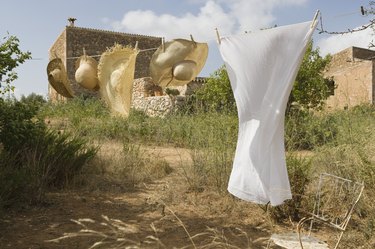
If you are making a hat, fabric box, basket or some other project that requires soft material, you will need to treat the fabric with a stiffener solution. Commercial fabric stiffeners are available, but there are also a number of at-home recipes homemakers used at the beginning of the 20th century which are still effective. Before you start your project, determine if your fabric requires permanent or temporary stiffening and choose your solution accordingly.
Commercial Fabric Stiffeners
Video of the Day
Commercial fabric stiffeners contain chemicals that make the fabric harder and are often used in place of liquid starch when the final product needs permanent stiffness, such as in the case of ornaments or signs. Commercial stiffeners are typically liquid and dry, leaving no traces on the fabric. Apply the liquid with a brush or a sponge and allow to dry for 45 minutes. Depending on your project, you can iron the fabric on a low setting or you can shape it before it dries.
Video of the Day
PVA Glue
PVA glue stiffens fabric permanently once the glue hardens. Dilute the glue using equal parts of glue and water and mix continuously to obtain a paste with an even consistency. Apply the glue with a paintbrush. Craft the fabric into the desired shape and leave to dry. Apply more coats, depending on how stiff you want your material to be.
Another way to stiffen the fabric is to immerse it into a bucket filled with diluted glue. The solution can be more or less concentrated, depending on the effects you want to obtain. Squeeze the fabric to remove the excess solution, shape it and allow to dry. A recipe that yields similar results involves using wallpaper paste instead of PVA glue.
Gelatin
Gelatin is a permanent fabric stiffener ideal for making hats or baskets. Use 2 oz. clear powdered gelatin in 2 cups of water. Heat up the water and mix with the gelatin, stirring until the powder dissolves. Pass the solution through a strainer and apply it on the fabric with a sponge or brush. Alternatively, place the fabric into the solution and squeeze out the redundant liquid with a sponge or a clean kitchen cloth.
Non-Permanent Stiffeners
If you are making dolls, plush animals, book signs, tablecloths or other projects that only require temporary stiffening, use a solution of sugar and water. Mix sugar with water in equal proportions and boil. Allow to cool and dip the fabric in the solution. Squeeze out the superfluous water, but avoid wringing the fabric. Shape and leave it to dry. Alternatively, use Epsom salts or liquid starch in the same proportions.
Interfacing
Interfacing is a fairly stiff material that can be sandwiched between two layers of fabric and is therefore invisible. It comes in a variety of weights and can be sewed on or ironed on. You can choose between woven, non-woven and knit. Woven has grain and must be cut the same way as the fabric, while non-woven has no grain. Knit has a high elasticity and is suitable for knit fabrics. Popular types of intefacing include pellon and buckram.